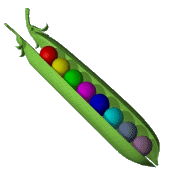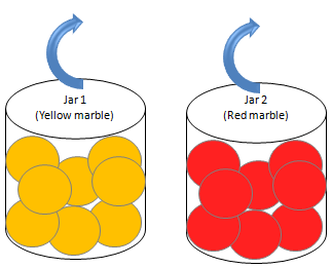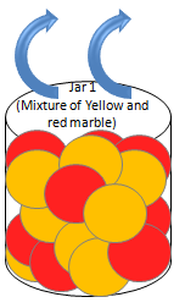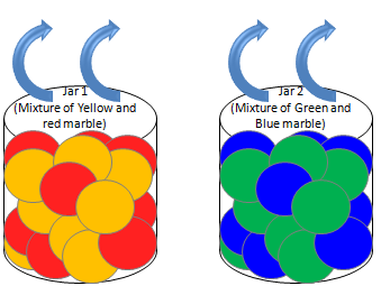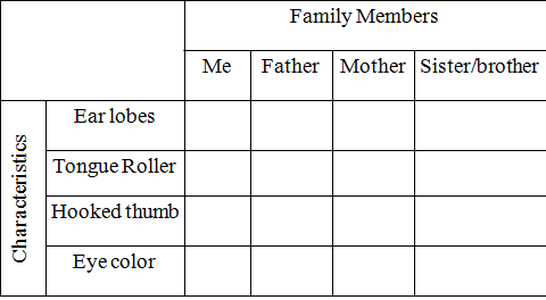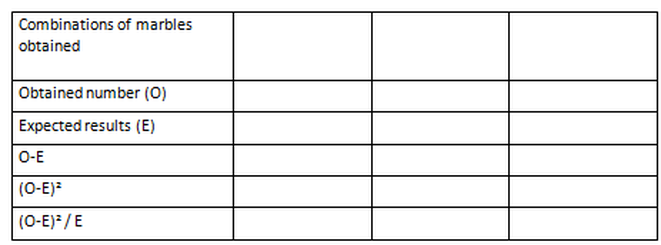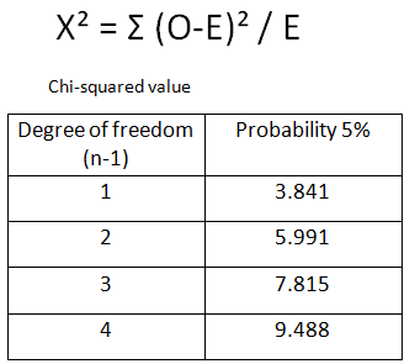You have done enough of the book exercise, lets now visualize Mendel's experiment. In The University of the South Pacific we did a experiment with maize to justify the ratios that Mendel came up with, it helped us to understand Mendel's Laws, experiment, result and his ratios better. We would not do the same experiment here but another experiment to just help students understand Mendel's Laws key points that he made.
The experiment is designed keeping in mind availability resources. To do this experiment all you need are four different colored marbles.
Topic: Transmission of Characters from Parents to Offspring
Aims:
- To understand the transmission of characters from generation to generation.
- To understand the Law of Segregation and the Law of Independent Assortment.
Introduction:
Look at your ear lobes are they lobed or not. Now check your parents and siblings ear lobes do you see any similarity.
Do you know how to roll your tongue? Ever wondered who in your family knows tongue rolling.Ask yourself, why i don't know tongue rolling when my parents do.
Do you know how to roll your tongue? Ever wondered who in your family knows tongue rolling.Ask yourself, why i don't know tongue rolling when my parents do.
Materials:
All you require to do the experiment are:
- Two small bags or jar or even a container will do.
- Four different color marble at least 15-20 each.
Method:
Part 1: Transmission of characteristics
Take the following notes on yourself and your family members in a table format.
- Ear lobe or no ear lobes.
- Tongue roller or non-tongue roller.
- Hooked thumb or straight thumb.
- Eye color.
Part 2: Law of Segregation
Take two jars and two different colored marbles.
Suppose the colors are yellow and red.
Put the red marbles in one jar and the other in the second jar.
Now pick one Marble from each jar. Note what you have picked from each jar.
Now mix the two colors together and put them in one jar. Now pick two marble at a time randomly without looking. Each time take a note of what you pick.
Part 3: Law of Independent Assortment
Take two jars and four different colored marbles.
Suppose you take yellow, red, green, and blue.
Fill one jar with yellow and red marble and the other jar with green and blue marble. Pick two marble from each jar randomly. Note down what you have picked.
Suppose you take yellow, red, green, and blue.
Fill one jar with yellow and red marble and the other jar with green and blue marble. Pick two marble from each jar randomly. Note down what you have picked.
Result Tables:
Part 1:
Draw the table like this and fill yes or no for each characteristics.
Part 2 & 3:
Draw the table something like this and fill it.
Results Treatment:
The results you have obtained can be tested against the expected ratios by using chi-squared test. Write what ratio would be expected if we followed Mendel's law in part 1 & 2.
Fill the table below.
The results you have obtained can be tested against the expected ratios by using chi-squared test. Write what ratio would be expected if we followed Mendel's law in part 1 & 2.
Fill the table below.
The obtained number are the ones you have got from the results table.The expected number will be the addition of the obtained number multiplied by the expected ratio. Which are 1:2:1 and 9:3:3:1.
For example:
Total number of combination obtained was 100. Than 100 x 1/3 will be homozygous (Red-Red and yellow-yellow), 100 x 2/3 will be heterozygous (red-yellow).
After filling the table test your results at 5% level of probability.
For example:
Total number of combination obtained was 100. Than 100 x 1/3 will be homozygous (Red-Red and yellow-yellow), 100 x 2/3 will be heterozygous (red-yellow).
After filling the table test your results at 5% level of probability.
Discussion:
Part 1:
Now compare the results you have obtained. What do you notice in terms of transmission of the characteristics in your family? Does everyone has the same characteristics, do the children have the same characteristics as either parent?
Part 2 & 3:
For the results you obtain what do you notice about the way the alleles (represented by the marbles) behave in part 1 and part 2.
Does your Chi-squared results suggest that your obtained values are significant?
Now compare the results you have obtained. What do you notice in terms of transmission of the characteristics in your family? Does everyone has the same characteristics, do the children have the same characteristics as either parent?
Part 2 & 3:
For the results you obtain what do you notice about the way the alleles (represented by the marbles) behave in part 1 and part 2.
Does your Chi-squared results suggest that your obtained values are significant?
| lab_exercise.pdf |
Now you are ready to do a quiz. Click on the next page icon to do the online quiz.
If you want us to have a look at your Lab work, email us at [email protected].
